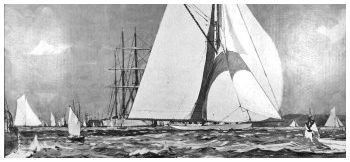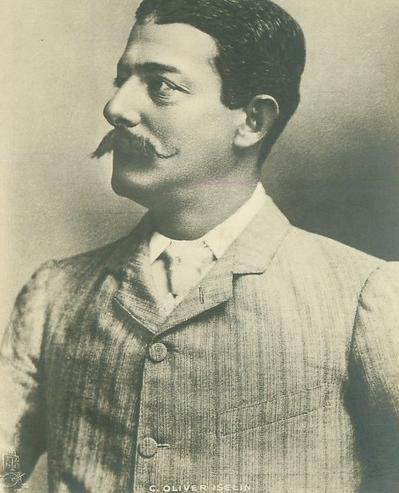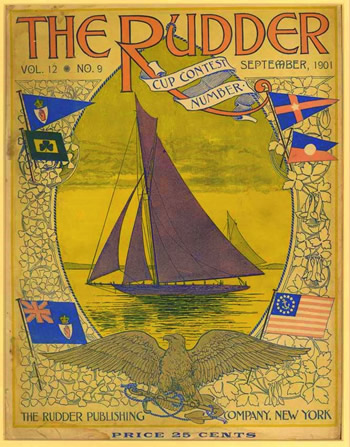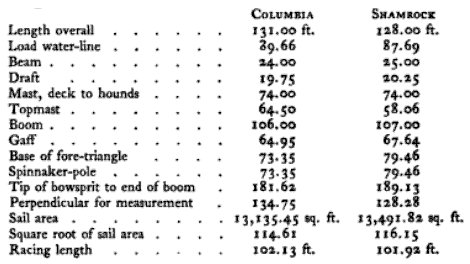Yves GARY Hits: 4729
Category: 1899 : CHALLENGE N°10
 On her arrival at New York, Shamrock was rigged promptly for racing, and was given several trials off Sandy Hook, in which she appeared to be a veritable witch in light airs. On September 13th she met with an accident, her steel gaff buckling until it collapsed. It may be mentioned here that her spars and gear were too light for her sails, which defect caused a loss of speed. She was finely handled by Capt. Archie Hogarth, assisted by Capt. Robert Wringe.
On her arrival at New York, Shamrock was rigged promptly for racing, and was given several trials off Sandy Hook, in which she appeared to be a veritable witch in light airs. On September 13th she met with an accident, her steel gaff buckling until it collapsed. It may be mentioned here that her spars and gear were too light for her sails, which defect caused a loss of speed. She was finely handled by Capt. Archie Hogarth, assisted by Capt. Robert Wringe.
On September 4th Columbia was formally selected to defend the cup, at a meeting held on board the New York Yacht Club flagship Corsair at Newport, and it was voted to notify Sir Thomas Lipton on September 25th of this choice. As Commodore Morgan was the chief owner of Columbia he resigned from the cup committee September 21st, and his place was filled by Vice Commodore Ledyard.
 At a conference between Sir Thomas Lipton and Mr. C. Oliver Iselin on September 27th, it was decided to change the conditions of the match with respect to starts, by agreeing to start no race after 12.30, instead of 1.30, as originally agreed upon. It was also agreed that each boat should have a representative present on the other boat during measurements. This was at Mr. Iselin's suggestion.
At a conference between Sir Thomas Lipton and Mr. C. Oliver Iselin on September 27th, it was decided to change the conditions of the match with respect to starts, by agreeing to start no race after 12.30, instead of 1.30, as originally agreed upon. It was also agreed that each boat should have a representative present on the other boat during measurements. This was at Mr. Iselin's suggestion.
The signals for starting were agreed upon as follows: Preparatory signal to be given at 10.45, warning signal at 10.55, and starting signal at 11 o'clock, with handicap gun two minutes after.
Another suggestion of Mr. Iselin's was that there is a special arrangement regarding accidents in races. This resulted in an agreement that in a race "each yacht shall stand by the consequences of any accident happening to her, and the uninjured vessel shall sail out the race," the parties believing" that the America's cup races are no less a test of the strength of construction of the competing vessels, than of their sailing qualities."
According to the original articles of agreement the regatta committee was given power to postpone starts in case of fog, agreed postponement, or serious accident, or "if, in their opinion, the space around the starting line is not sufficiency clear at the time appointed for the start." The time limit was set at five and a half hours, unfinished races to be repeated until finished. The vessels were to be given reasonable time to repair in case of accidents sustained before receiving the preparatory signal.
The vessels were allowed three men to every five feet of racing length when measured, the agreement as to measuring being the same as that in the Dunraven conditions, and it further was agreed that the water-line should be marked “at the bow and as far aft as possible, on each vessel."
These latter arrangements stood as originally made in September 1898. In the original agreement races were to have been sailed on Tuesdays, Thursdays and Saturdays. On October 8th, 1899, it was found advisable to change this arrangement, and it was agreed to consider every week day, after October 12th, a race day.
 There was little fear that the courses in the races would be crowded by steamers, for the United States government, for the first time, exercised authority to keep a clear course, under a special act of congress, passed May 19th, 1896, at the instance of members of the New York Yacht Club and other yachtsmen. This act was an amendment to section 4487 of the revised statutes, navigation laws of the United States, and was as follows:
There was little fear that the courses in the races would be crowded by steamers, for the United States government, for the first time, exercised authority to keep a clear course, under a special act of congress, passed May 19th, 1896, at the instance of members of the New York Yacht Club and other yachtsmen. This act was an amendment to section 4487 of the revised statutes, navigation laws of the United States, and was as follows:
In order to provide for the safety of passengers on excursion steamers, yachts, oarsmen and all craft whether as observers or participants, taking part in regattas, amateur or professional, that may hereafter be held on navigable waters, the secretary of the treasury be, and he is hereby, authorized and empowered, in his discretion, to detail revenue cutters to enforce such rules and regulations as may be adopted to insure the safety of passengers on said excursion steamers, yachts, oarsmen and all craft, whether as observers or participants, taking part in such regattas.
Under the authority conferred by this act Hon. Lyman Gage, secretary of the treasury, ordered Capt. (afterwards Rear-Admiral) Robley D. Evans to assume charge of a patrol of government vessels to keep clear the courses for the racers. The patrol fleet consisted of six revenue cutters and six torpedo boats. To this fleet were added by Capt. Evans Corsair and Erin, steam-yachts, half a dozen tugs used by newspaper men, and the naval militia converted yacht Aileen. The cutters used were: Manning, Capt. W. H. Roberts; Onondaga, Capt. David A. Hall; Algonquin, Capt. Owen S. Wiley; Gresham, Capt. Thomas D. Walker; Windom, Capt. George H. Gooding. Capt. Evans' flag was on the Manning. The torpedo boats were the Porter, Dupont, Morris, McKensie, Winslow' and Stiletto. These were in command of Lieut. Commander J. C. Fremont, U. S. N.
The patrol maintained by these vessels was distinguished for its thoroughness, and the ease with which the enormous excursion fleets were handled. Charts showing the courses, and detailed instructions as to how vessels should move, were issued to every captain in the fleet, and having the government stamp of authority they carried weight; though it may be said, in justice to the captains, that everyone was ready to use all means in his power to help the patrol.
It was planned to give the yachts one mile of clear water in which to sail at all times, and half a mile on all sides at starts. This was done to the letter throughout the series of races, crowding thus becoming a thing of the past.
According to custom, the competing yachts were measured at Erie Basin the day before that set for the first race. The result of the measuring was something of a surprise to yachting critics, who expected Shamrock to prove the larger boat. Though heavier in form and lines, she did not, as the following comparison of the official figures shows:

Columbia allowed Shamrock 6.31 seconds.
 Publié : October 3, 1899 |
ADVANTAGE FOR SHAMROCK |
||
 Publié : October 3, 1899 |
NOW COMES THE GREAT INTERNATIONAL STRUGGLE FOR THE AMERICA’S CUP. |
Page |
Page |
 Publié : October 3, 1899 |
SIX SECONDS TO SHAMROCK. |
Page |
Page |
With this measuring the boats were ready for the series. The representative of the Royal Ulster Yacht Club on Columbia was to be Mr. Hugh C. Kelly, and that of the New York Yacht Club on Shamrock Mr. Henry F. Lippitt.
